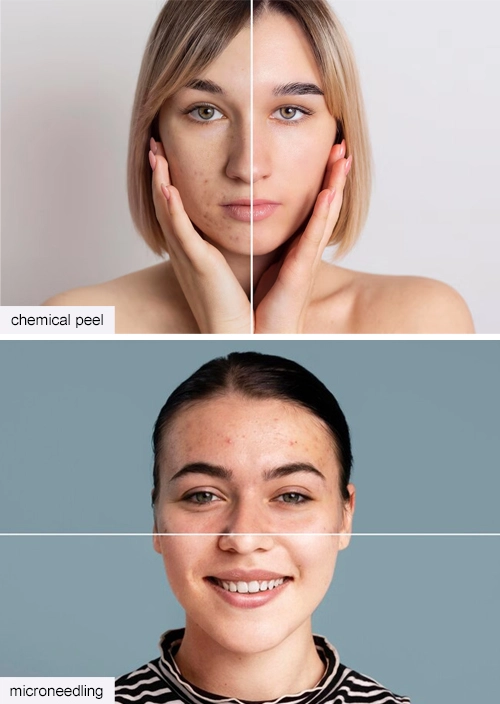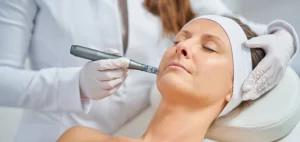There are several treatment choices when it comes to achieving glowing and younger-looking skin. Two of the most popular and effective ones are Chemical Peels and Microneedling.
Chemical peels use special solutions to scrub away old skin, making the new skin come to the surface; while microneedling uses tiny needles to make your skin produce more collagen and look smoother.
In today’s blog, we will explore Microneedling vs Chemical Peel and discuss their benefits, helping you decide which treatment might be best for your skin. If you’re looking to enhance your skin’s rejuvenation further, you might also explore Botox treatments in NYC.
A Brief Overview of Chemical Peel
A chemical peel involves the application of a chemical solution to the skin, which causes controlled exfoliation of the outer layers. This process removes dead skin cells, stimulates collagen production, and reveals smoother, rejuvenated skin underneath.
Chemical peels can vary in depth, from superficial peels that target mild skin imperfections to deep peels that penetrate deeper layers for more significant results.
Levels of Chemical Peels
Chemical peels are categorized into three levels:
- Superficial peels: Superficial chemical peels use mild acids like alpha hydroxy acids (AHAs) to exfoliate the outer layer of the skin, providing a gentle refresh. They’re suitable for mild skin concerns and have minimal downtime.
- Medium peels: These penetrate deeper into the skin with acids like glycolic or trichloroacetic acid (TCA), targeting moderate skin imperfections like fine lines, wrinkles, and pigment irregularities. Downtime and side effects are more significant compared to superficial peels. Besides, glycolic acid peel burns after application.
- Deep peels: Utilizing strong acids like phenol, deep peels reach the deeper layers of the skin, effectively treating severe wrinkles, scars, and sun damage. They require extensive downtime and are typically performed under sedation by a dermatologist or plastic surgeon.
A Brief Overview of Microneedling
Microneedling, also known as collagen induction therapy, utilizes a device with fine needles to create tiny punctures in the skin. These micro-injuries stimulate the skin’s natural healing response, leading to increased collagen and elastin production.
As the skin heals, it becomes firmer, smoother, and more even in tone and texture. Microneedling is effective for treating acne scars, wrinkles, and large pores. It will improve overall skin texture.
Microneedling vs Chemical Peel
Chemical peel treatments employ acids to exfoliate and rejuvenate the skin’s surface, targeting issues like hyperpigmentation and fine lines. On the other hand, microneedling involves creating tiny punctures in the skin to stimulate collagen production and improve texture, scars, and wrinkles.
Each method offers distinct benefits, with peels focusing on surface concerns and microneedling addressing deeper skin issues. Choosing between them depends on individual skin goals and preferences.
Microneedling vs Chemical Peel Pros
| Microneedling | Chemical Peel |
| Stimulates collagen production, improving uneven skin texture and firmness. | Addresses a wide range of skin concerns, including acne scarring, hyperpigmentation, and sun damage. |
| Effective for treating scars, including acne scars, and reducing pore size. | Offers customizable options for different skin types and concerns, from superficial to deep peels. |
| Minimal downtime and relatively low risk of post-treatment pigmentation issues. | Delivers noticeable results after just one treatment, with continued improvement over time. |
| Compatible with various skin types and can be customized for different concerns. | Shorter treatment time compared to microneedling sessions. |
Microneedling vs Chemical Peel Cons
| Microneedling | Chemical Peel |
| It may require multiple sessions for optimal results. | Potential for adverse reactions such as redness, peeling, and sensitivity, especially with deeper peels. |
| Potential for temporary redness, swelling, and discomfort during and after treatment. | Requires downtime for skin recovery, varying depending on the depth of the peel. |
| Risk of infection if not performed by a trained professional or with proper sterilization. | Not suitable for individuals with certain skin conditions, such as eczema or rosacea. |
| Isn’t suitable for certain skin conditions like active acne or eczema. | Sun sensitivity post-treatment necessitates strict sun protection measures to prevent damage. |
Acne Scars Treatment
Exactly, both microneedling and chemical peels offer distinct approaches to treating acne scars. Microneedling’s stimulation of collagen production helps to improve the skin’s texture and fill in depressed scars gradually. It’s versatile and effective to treat acne scars.
On the other hand, chemical peels work by exfoliating the skin’s top layers, which can fade hyperpigmentation and shallow scars. While they may need multiple sessions, their range of strengths caters to different scar severities and skin types. Each method has its advantages, and the choice often depends on individual scar characteristics and preferences.
Procedure
- Chemical Peel: Application of a chemical solution, which is left on the skin for a specific period before being neutralized and removed.
- Microneedling: A device with fine needles is gently rolled over the skin to create controlled micro-injuries.
Risks
| Microneedling | Chemical Peel |
| Risk of infection if proper sterilization protocols are not followed during the procedure. | Post-inflammatory hyperpigmentation or hypopigmentation, especially with deeper peels or in individuals with darker skin tones. |
| Temporary redness, swelling, and discomfort immediately following treatment, which usually subsides within a few days. | Risk of allergic reactions or skin irritation due to the chemicals used in the peel solution. |
| Possibility of post-inflammatory hyperpigmentation, especially in individuals with a history of pigmentation disorders. | Potential for scarring, particularly with aggressive or improper application. |
| Formation of granulomas or keloids in response to the microneedling process, particularly in predisposed individuals. | Increased sensitivity to sunlight and risk of sunburn, necessitating strict sun protection post-treatment. |
Causes
- Chemical Peel: Chemical solution causes controlled injury to the skin’s surface layers, prompting renewal and regeneration.
- Microneedling: The mechanical action of needles stimulates the skin’s wound-healing response, triggering collagen production.
Which is Better for Acne?
Microneedling targets acne scars and improves skin texture, while chemical peels are effective for controlling oiliness and reducing inflammation associated with active acne. The choice depends on your specific skin concerns and goals.
Pain level
- Chemical Peel: Minimal discomfort during application, potential tingling or burning sensation.
- Microneedling: Mild to moderate discomfort during the procedure, typically managed with topical numbing cream.
Frequency of treatment
Chemical Peel depending on the type, may require multiple sessions spaced several weeks apart. For microneedling, multiple sessions are recommended for best skin peel results, usually spaced 4-6 weeks apart.
Cost of Microneedling and Chemical Peels
The cost of chemical peel is based on the type and depth of the peel, generally lower per session compared to deep chemical peels. However, microneedling is slightly more expensive per session, but fewer sessions may be needed overall to achieve the desired results.
Who is it for?
Chemical peel is suitable for most skin types, including darker skin tones, with appropriate formulation adjustments. Besides, microneedling is generally safe for all skin types, including a sensitive and uneven skin tone.
Aftercare Routines
– Dos
After chemical peel and micro-needling treatment, you need to take care of a few things, such as:
- Avoid sun exposure
- Use gentle skincare products
- Follow post-peel instructions provided by your dermatologist
However, it will help you to protect treated skin, promote healing, and optimize results.
– Don’ts
After undergoing microneedling or a chemical peel, follow some guidelines to ensure proper healing and optimal results. Here are some don’ts to keep in mind:
- Don’t Touch or Pick at Your Skin
- Don’t Apply Harsh Products
- Don’t Use Hot Water or Steam
- Don’t Use Makeup or Cosmetics
- Don’t Submerge Your Face in Water
- Don’t Skip Moisturizing
Chemical Peel vs Botox
A chemical peel involves the application of a chemical solution to exfoliate the skin, removing dead skin cells and stimulating the growth of new, healthier skin. It’s used to improve the skin’s texture, tone, and appearance, targeting issues like fine lines, wrinkles, acne scars, and hyperpigmentation.
Botox nyc, or botulinum toxin, is a neurotoxin injected into specific muscles to temporarily paralyze them, reducing the appearance of wrinkles and fine lines caused by muscle movement. It’s commonly used to treat dynamic wrinkles, such as forehead lines, crow’s feet, and frown lines between the eyebrows.
Chemical Peel vs Microneedling Before and After

Microneedling Before and After Wrinkles

Microneedling Before and After Pores

Skin Peeling after Microneedling

Bad Microneedling

Final Verdict: Who Wins?
Choosing between a chemical peel and microneedling depends on your specific skin concerns, tolerance for downtime, and desired outcomes. While deep chemical peels are effective for overall skin rejuvenation and addressing pigmentation issues, deep microneedling excels in treating acne scars, and wrinkles, and enhancing skin texture through collagen induction.
Consulting with a skin care professional can help determine the best skin peel treatment plan tailored to your individual needs, ensuring optimal results and healthier, more radiant skin.
Frequently Asked Questions
Should I do a chemical peel before or after microneedling?
It’s generally recommended to do a chemical peel before microneedling for optimal results.
What’s better than microneedling?
Treatments like laser therapy or radiofrequency microneedling are considered alternatives that may yield different benefits than microneedling alone.
Does a chemical peel get rid of wrinkles?
Chemical peels can help reduce the appearance of wrinkles over time with regular sessions, but they may not eliminate them.
How often should you do microneedling?
Microneedling is typically done every 4-6 weeks for a series of sessions, depending on your skin’s needs and the desired outcome.
Is one microneedling session enough?
Multiple microneedling sessions are often required to achieve desired results, with maintenance sessions recommended for long-term benefits.
Do you do skincare before or after microneedling?
Skincare before microneedling should be gentle, avoiding harsh exfoliates or active ingredients that could irritate the skin.
What treatments can you combine with microneedling?
Microneedling can be combined with treatments like PRP (platelet-rich plasma) therapy or topical serums for enhanced results.
How long after a chemical peel can I get microdermabrasion?
It’s best to wait at least 2-4 weeks after a chemical peel before undergoing microdermabrasion to allow the skin to fully recover.
Are Chemical Peels Safe?
Chemical peels are generally safe when performed by a qualified professional, but risks can include irritation, redness, or hyperpigmentation.
Can chemical peels remove scars?
Chemical peels can improve the appearance of scars, but results vary depending on the type and severity of the scars.

About The Author
Dr. Syra Hanif M.D.
Board Certified Primary Care Physician
Dr. Hanif is the Director of Aesthetic Medicine. She is a board-certified physician in Aesthetic Medicine who specializes in using non-surgical alternatives in order to enhance one's appearance through Botox and fillers.
Read More











